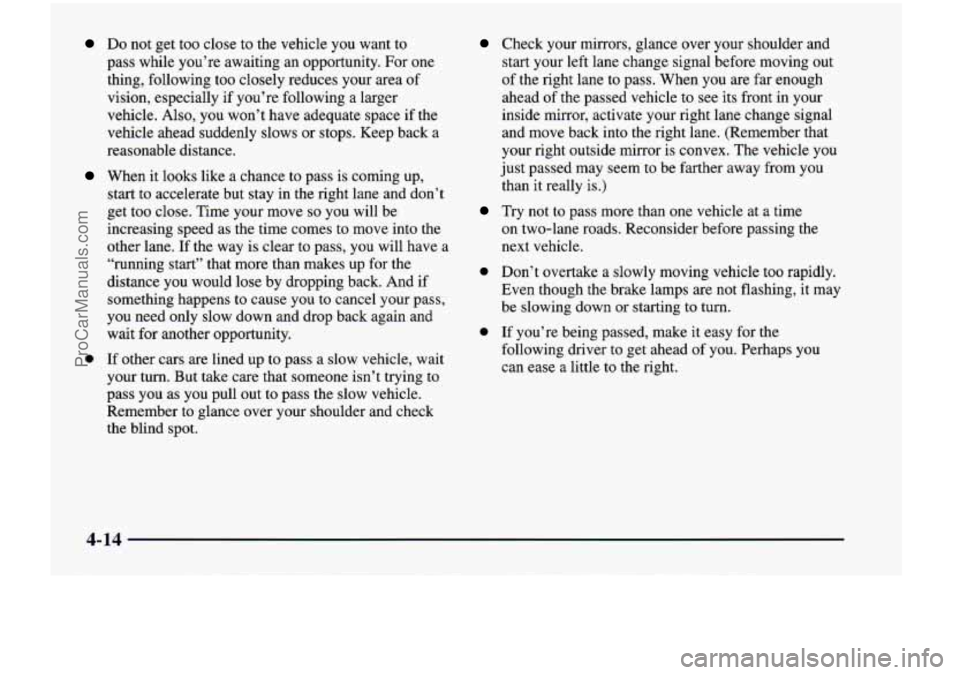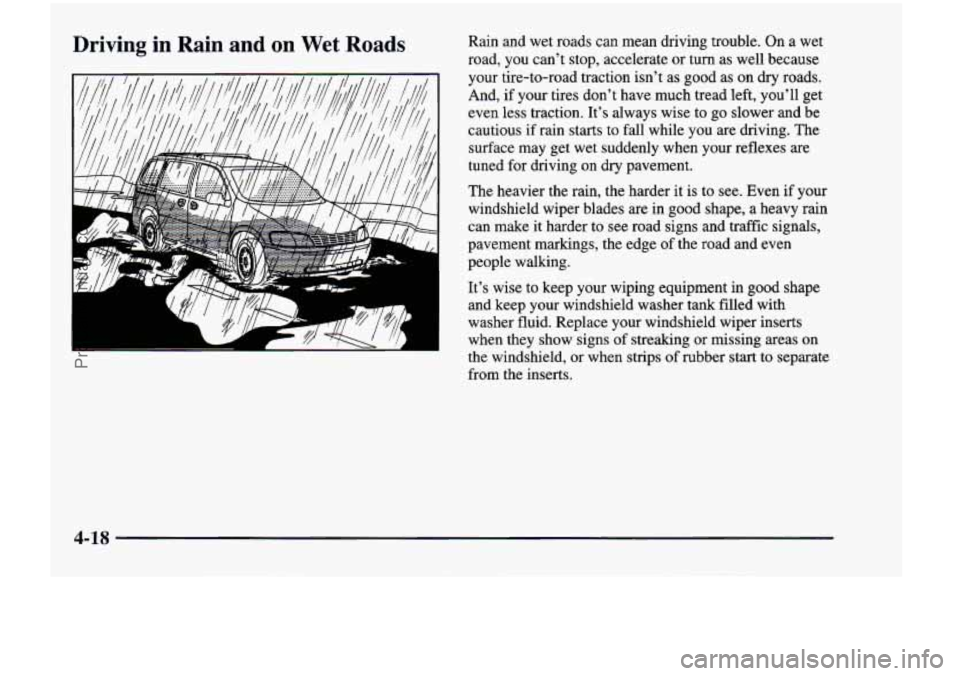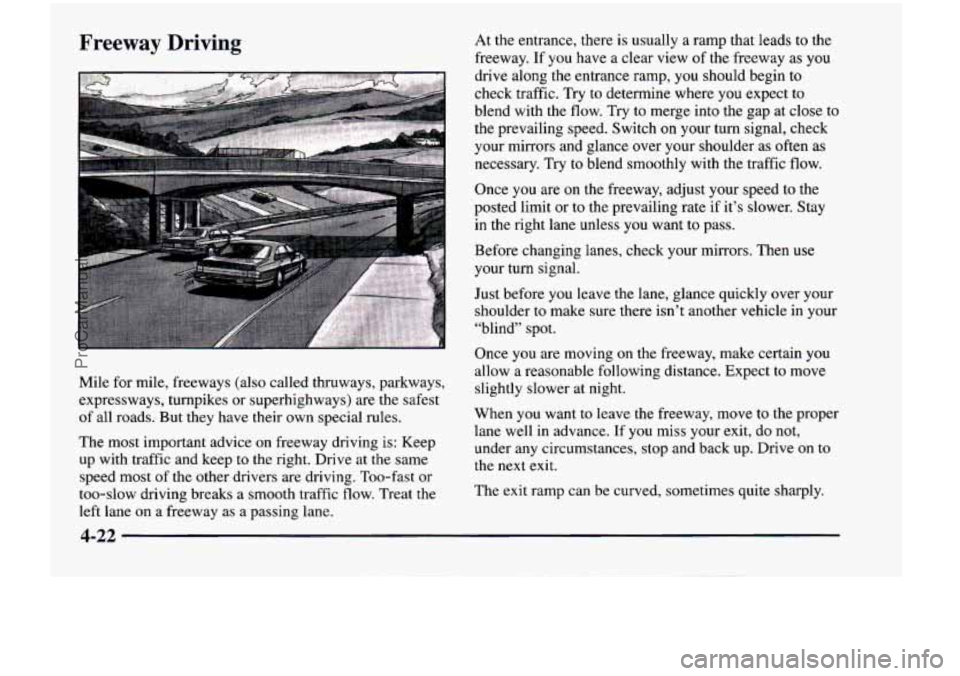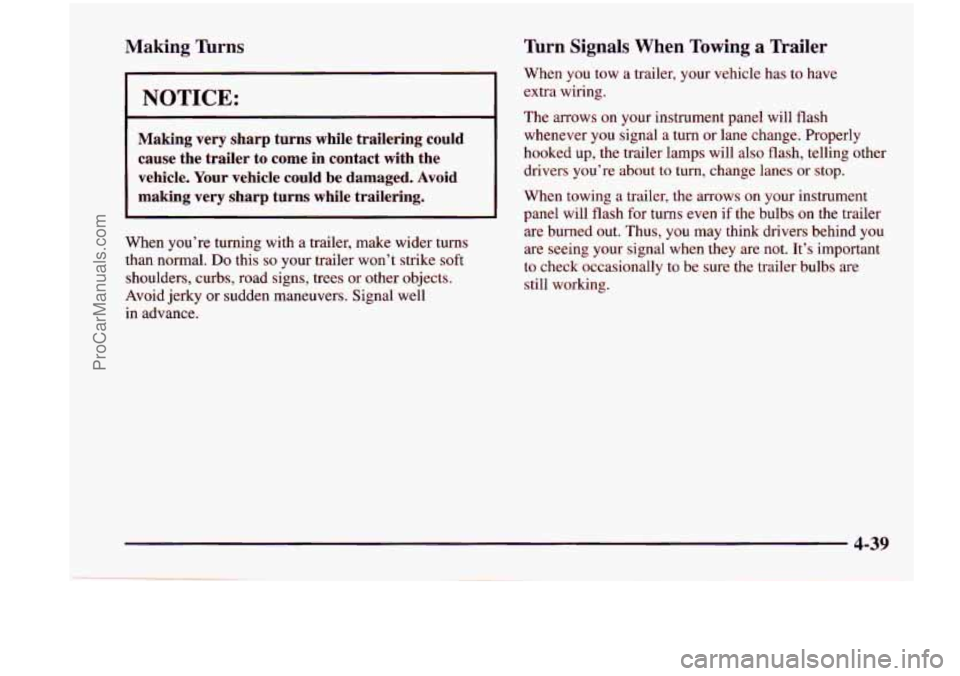Page 267 of 474

Do not get too close to the vehicle you want to
pass whde you’re awaiting an opportunity. For one thing, following too closely reduces your area of
vision, especially if you’re following a larger
vehicle.
Also, you won’t have adequate space if the
vehicle ahead suddenly slows or stops. Keep back a
reasonable distance.
When it looks like a chance to pass is coming up,
start to accelerate but stay in the right lane and don’t
get too close. Time your move
so you will be
increasing speed as the time comes to move into the
other lane. If the way
is clear to pass, you will have a
“running start” that more than makes up for the
distance you would lose by dropping back. And
if
something happens to cause you to cancel your pass,
you need only slow down and drop back again and
wait for another opportunity.
0 If other cars are lined up to pass a slow vehicle, wait
your turn. But take care that someone isn’t trying to
pass you as you pull out to pass the slow vehicle.
Remember to glance over your shoulder and check
the blind spot.
Check your mirrors, glance over your shoulder and
start your left lane change signal before moving out
of the right lane to pass. When you
are far enough
ahead of the passed vehicle to see its front in your
inside mirror, activate your right lane change signal
and move back into the right lane. (Remember that
your right outside mirror is convex. The vehicle you
just passed may seem to be farther away from you
than it really is.)
Try not to pass more than one vehicle at a time
on two-lane roads. Reconsider before passing the
next vehicle.
0 Don’t overtake a slowly moving vehicle too rapidly.
Even though the brake lamps are not flashing, it may
be slowing down or starting
to turn.
0 If you’re being passed, make it easy for the
following driver
to get ahead of you. Perhaps you
can ease
a little to the rieht.
4-14
ProCarManuals.com
Page 271 of 474

Driving in Rain and on Wet Roads
---
I!
Rain and wet roads can mean driving trouble. On a wet
road, you can’t stop, accelerate or turn as well because
your tire-to-road traction isn’t as good as on dry roads.
And, if your tires don’t have much tread left, you’ll get
even less traction. It’s always wise to go slower and be
cautious if rain starts to fall while you are driving. The
surface may get wet suddenly when your reflexes are
tuned for driving on
dry pavement.
The heavier the rain, the harder it is to see. Even if your
windshield wiper blades
are in good shape, a heavy rain
can make it harder to see road signs and traffic signals,
pavement markings, the edge of the road and even
people walking.
It’s wise to keep your wiping equipment in good shape
and keep your windshield washer tank filled with
washer fluid. Replace your windshield wiper inserts
when they show signs
of streaking or missing areas on
the windshield, or when strips of rubber start to separate
from the inserts.
4-18
ProCarManuals.com
Page 274 of 474
City Driving
One of the biggest problems with city streets is the
amount of traffic on them. You’ll want to watch out for
what the other drivers are doing
and pay attention to
traffic signals. Here
are ways
to increase your safety in city driving:
Know the best way to get to where you are
going. Get a city map and plan your trip into an
unknown part of the city just as you would for a
cross-country trip.
Try to use the freeways that rim and crisscross most
large cities. You’ll save time and energy.
(See the
next part, “Freeway Driving.”)
0 Treat a green light as a warning signal. A traffic
light is there because the corner
is busy enough to
need it. When a light turns green,
and just before you
start to move, check both ways for vehicles that have
not cleared the intersection or may be running the
red light.
4-21
ProCarManuals.com
Page 275 of 474

Freeway Driving
Mile for mile, freeways (also called thruways, parkways,
expressways, turnpikes or superhighways) are the safest
of all roads. But they have their own special rules.
The most important advice on freeway driving is: Keep
up with traffic and keep to the right. Drive at the same
speed most of the other drivers are driving. Too-fast
or
too-slow driving breaks a smooth traffic flow. Treat the
left lane on a freeway as a passing lane. At the entrance, there
is usually a ramp that leads to the
freeway.
If you have a clear view of the freeway as you
drive along the entrance ramp, you should begin to
check traffic. Try to determine where you expect to blend with the flow. Try to merge into the gap at close to
the prevailing speed. Switch
on your turn signal, check
your mirrors and glance over your shoulder as often
as
necessary. Try to blend smoothly with the traffic flow.
Once you are on the freeway, adjust your speed to the
posted limit or to the prevailing rate if it’s
slower. Stay
in the right lane unless you want to pass.
Before changing lanes, check your mirrors. Then
use
your turn signal.
Just before you leave the lane, glance quickly over your shoulder to make sure there isn’t another vehicle in your
“blind” spot.
Once you are moving on the freeway, make certain you
allow a reasonable following distance. Expect
to move
slightly slower at night.
When you want to leave the freeway, move
to the proper
lane well in advance. If you miss your exit, do not,
under any circumstances, stop and back up. Drive
on to
the next exit.
The exit ramp can be curved, sometimes quite sharply.
4-22
ProCarManuals.com
Page 292 of 474

Making nrns
NOTICE:
Making very sharp turns while trailering could
cause the trailer
to come in contact with the
vehicle. Your vehicle could be damaged.
Avoid
making very sharp turns while trailering.
When you’re turning with a trailer, make wider turns
than normal.
Do this so your trailer won’t strike soft
shoulders, curbs, road signs, trees or other objects.
Avoid jerky or sudden maneuvers. Signal well
in advance.
Turn Signals When Towing a Trailer
When you tow a trailer, your vehicle has to have
extra wiring.
The arrows on your instrument panel will flash
whenever you signal a turn or lane change. Properly
hooked up, the trailer lamps will also flash, telling other
drivers you’re about to turn, change lanes
or stop.
When towing a trailer, the arrows on your instrument
panel will flash
for turns even if the bulbs on the trailer
are burned out. Thus, you may think drivers behind
you
are seeing your signal when they are not. It’s important
to check occasionally to be sure the trailer bulbs are
still working.
4-39
ProCarManuals.com
Page 299 of 474
Hazard Warning Flashers
Your hazard warning flashers let you warn others. They
also let police know you have a problem. Your front and
rear turn signal lamps will flash on and off.
Your hazard warning
flashers button is on top
of
the steering column. Press
the button in to turn on
your flashers.
Your hazard warning flashers work no matter what
position your key is in, and even
if the key isn’t in.
To turn off the flashers, push the button down and it will
pop back up by itself.
When the hazard warning flashers
are on, your turn
signals won’t work.
Other Warning Devices
If you carry reflective triangles, you can set one up at
the side of the road about
300 feet (100 m) behind
your vehicle.
5-2
ProCarManuals.com
Page 366 of 474
Also, for your audio system, see “Theft-Deterrent
Feature”
in the Index.
Jump Starting
For jump starting instructions, see “Jump Starting” in
the Index.
Bulb Replacement
Halogen Bulbs
Halogen bulbs have pressurized gas inside and
can burst if you drop or scratch the bulb. You or
others could be injured. Be sure to read and
follow the instructions on the bulb package.
Headlamps
NOTICE:
When replacing the headlamp bulb, do not leave
the bulb out for any length of time. This could
cause nitrogen gas to escape from the lamp.
To
minimize nitrogen gas from escaping within the
headlamp, the headlamp must be placed on
a flat
surface with the lens facing down when removing
the bulb.
1. Open the hood.
2. Remove the front parking/turn signal lamp assembly.
See “Front Parkingmum Signal
Lamps” later in
this section.
6-31
ProCarManuals.com
Page 369 of 474
9. Align the pins on the bottom of the headlamp
assembly with the holes in the lamp support bracket
while placing the holes in the assembly over the
bolts where the wing nuts attach.
10. Replace and tighten the wing nuts. 11. Replace the parkinglturn signal lamp assembly by
lining up the tabs at the back of the assembly with
the holes in the fender.
12. Tighten the bolt connecting the parkinghurn signal lamp assembly.
Be sure the tab from the
parking/turn signal lamp assembly is inboard of
the tab from the headlamp assembly.
Front Parkinern Signal Lamps
1. Open the hood.
k
2. Remove the thumb screw attaching the parking/turn
signal lamp assembly to the headlamp assembly.
3. Pull the parkinghrn signal lamp assembly away
from the body.
4. Unscrew the bulb socket from the lamp assembly by
pressing the tab while turning it to the left.
6-34
ProCarManuals.com